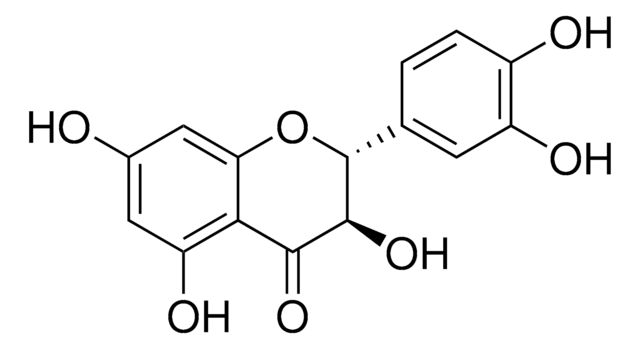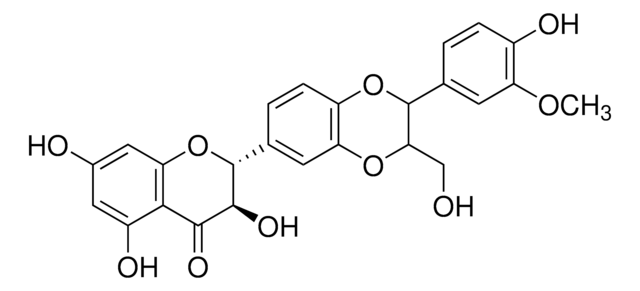This product is a fairly crude extract from Milk Thistle consisting of a number of components. The minimum purity specification for this material is 30%. Within that fraction there is a mixture of isomers. The amount of each has not been quanitified, however the literature suggests that these are present in the plant at equimolar ratios. Please see the link below to review a sample or lot specific Certificate of Analysis:
https://www.sigmaaldrich.com/product/sigma/s0292#product-documentation
S0292
Silymarin
flavonolignans
Synonym(s):
flavolignans
About This Item
Recommended Products
biological source
plant (Silybum marianum)
Quality Level
form
powder
technique(s)
toxicology assay: suitable
application(s)
microbiology
storage temp.
−20°C
SMILES string
O1C(C(Oc3c1ccc(c3)C4Oc5c(c(cc(c5)O)O)C(=O)C4O)c2cc(c(cc2)O)OC)CO
InChI
1S/C25H22O10/c1-32-17-6-11(2-4-14(17)28)24-20(10-26)33-16-5-3-12(7-18(16)34-24)25-23(31)22(30)21-15(29)8-13(27)9-19(21)35-25/h2-9,20,23-29,31H,10H2,1H3
InChI key
SEBFKMXJBCUCAI-UHFFFAOYSA-N
General description
Application
Biochem/physiol Actions
Other Notes
Storage Class Code
11 - Combustible Solids
WGK
WGK 3
Flash Point(F)
Not applicable
Flash Point(C)
Not applicable
Personal Protective Equipment
Choose from one of the most recent versions:
Already Own This Product?
Find documentation for the products that you have recently purchased in the Document Library.
Customers Also Viewed
-
This silymarine.....is it isomer of Silybinin A and B
1 answer-
Helpful?
-
-
I want to give it orally to a mouse. How should I prepare it?
1 answer-
This product has not been tested for in vivo or in vitro use. The solubility of this compound is tested at 10 mg/mL in ethanol, which may not be ideal for animal models. There are numerous published papers noting oral administration in mice.
See the links below to review examples:
https://www.ncbi.nlm.nih.gov/pmc/articles/PMC5156955/
https://www.ncbi.nlm.nih.gov/pmc/articles/PMC5622766/Please note that unless otherwise stated, this product is intended for research use only and is not to be used for any other purpose, which includes but is not limited to, unauthorized commercial uses, in vitro diagnostic uses, ex vivo or in vivo therapeutic uses or any type of consumption or application to humans or animals.
Helpful?
-
-
how can we dissolve silymarin ( in vitro study )
1 answer-
The solubility of this material is tested at a concentration of 50 mg per 5 mL of ethanol, giving a clear to slightly hazy appearance.
Helpful?
-
Active Filters
Our team of scientists has experience in all areas of research including Life Science, Material Science, Chemical Synthesis, Chromatography, Analytical and many others.
Contact Technical Service





